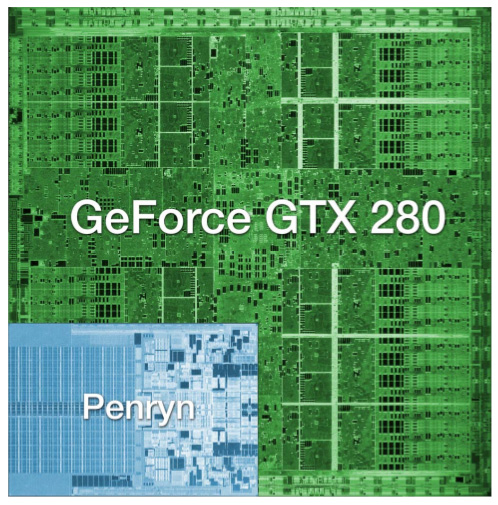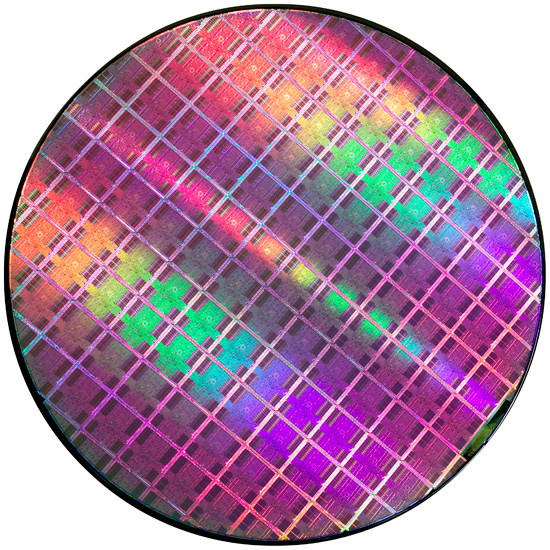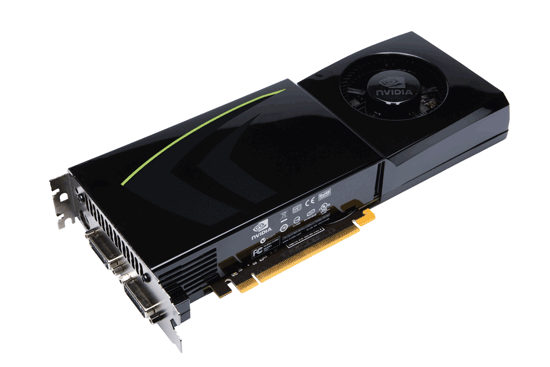NVIDIA's 1.4 Billion Transistor GPU: GT200 Arrives as the GeForce GTX 280 & 260
by Anand Lal Shimpi & Derek Wilson on June 16, 2008 9:00 AM EST- Posted in
- GPUs
One-Point-Four-Billion. That's transistors folks.
The chip is codenamed GT200 and it's the successor to NVIDIA's G80 and G92 families. Why the change in naming? The GT stands for "Graphics Tesla" and this is the second generation Graphics Tesla architecture, the first being the G80. The GT200 is launching today in two flavors, the die of the larger one is pictured below:

Um...yeah...we're reviewing that today
(this die comparison is to scale and that's a dual-core Penryn)
Let's put aside all the important considerations for a moment and bask in the glow of sheer geekdom. Intel's Montecito processor (their dual core Itanium 2) weighs in at over 1.7 billion transistors, but the vast majority of this is L3 cache (over 1.5 billion transistors for 24MB of on die memory). In contrast, the vast majority of the transistors on NVIDIA's GT200 chip are used for compute power. Whether or not NVIDIA has used these transistors well is certainly the most important consideration for consumers, but there's no reason we can't take a second to be in awe of the sheer magnitude of the hardware. This chip is packed full of logic and it is huge.

At most, 94 NVIDIA GT200 die can be produced on a single 300mm 65nm wafer from TSMC. On the other end of the spectrum, Intel can fit around 2500 45nm Atom processors on a 300mm wafer.
If the number of transistors wasn't enough to turn this thing into a dinner plate sized bit of hardware, the fact that it's fabbed on a 65nm process definitely puts it over the top. Current CPUs are at 45nm and NVIDIA's major competitor in the GPU market, AMD, has been building 55nm graphics chips for over 7 months now. With so many transistors, choosing not to shrink their manufacturing process doesn't seem to make much sense to us. Smaller fab processes offer not only the potential for faster, cooler chips, but also significantly reduce the cost of the GPU itself. Because manufacturing costs are (after ramping production) on a per wafer basis, the more dies that can be packed onto a single waffer, the less each die costs. It is likely that NVIDIA didn't want to risk any possible delays arising from manufacturing process changes on this cycle, but that seems like a risk that would have been worth taking in this case.
Instead, GT200 is the largest die TSMC has ever fabbed for production. Quite a dubious honor, and I wouldn't expect NVIDIA to really see this as something of which to be proud. Of course, that doesn't mean we can't be impressed with the sheer massiveness of the beast.
And what do we get from all these transistors? Moving up from 690M transistors of the original G80 and 754M transistors in G92 to the 1.4B transistors of GT200 is not a small tweak. One of the major new features is the ability to processes double precision floating point data in hardware (there are 30 64-bit FP units in GT200). The size of the register file for each SP array has been doubled. The promised ability of an SP to process a MAD and a MUL at the same time has been enhanced to work in more cases (G80 was supposedly able to do this, but the number of cases where it worked as advertised were extremely limited). And the number of SPs has increased from 128 on G80 to 240 with GT200. To better understand what all this means, we'll take a closer look at the differences between G80 and GT200, but first, the cards.
Clock Speeds, Pricing and HDMI Information
NVIDIA is introducing two GT200 parts today along with slightly tweaked branding. The new brand is called the GeForce GTX, and the first two cards are the GTX 280 and GTX 260.
Here's the card, say hello:

The GeForce GTX 280
It's got a little sibling too:

The GeForce GTX 260
The GeForce GTX 280 features 240 streaming processors running at 1.3GHz. It's got a 512-bit memory interface to 1GB of GDDR3 running at 2.2GHz (1107MHz core clock). The rest of the GPU runs at 602MHz.
| |
GTX 280 | GTX 260 | 9800 GX2 | 9800 GTX | 8800 GTS 512 | 8800 GT |
| Stream Processors | 240 | 192 | 256 | 128 | 128 | 112 |
| Texture Address / Filtering | 80 / 80 | 64 / 64 | 128 / 128 | 64 / 64 | 56 / 56 | 56 / 56 |
| ROPs | 32 | 28 | 32 | 16 | 16 | 16 |
| Core Clock | 602MHz | 576MHz | 600MHz | 675MHz | 650MHz | 600MHz |
| Shader Clock | 1296MHz | 1242MHz | 1500MHz | 1690MHz | 1625MHz | 1500MHz |
| Memory Clock | 1107MHz | 999MHz | 1000MHz | 1100MHz | 970MHz | 900MHz |
| Memory Bus Width | 512-bit | 448-bit | 256-bit x 2 | 256-bit | 256-bit | 256-bit |
| Frame Buffer | 1GB | 896MB | 1GB | 512MB | 512MB | 512MB |
| Transistor Count | 1.4B | 1.4B | 1.5B | 754M | 754M | 754M |
| Manufacturing Process | TSMC 65nm | TSMC 65nm | TSMC 65nm | TSMC 65nm | TSMC 65nm | TSMC 65nm |
| Price Point | $650 | $400 | $500 | $300 | $280 | $170-$230 |
You'll need a power supply that can deliver up to 236W for the card itself and you'll need both a 6-pin and an 8-pin PCIe power connector (the board won't work with two 6-pin connectors).
The GeForce GTX 280 will retail for $650 with availability planned for June 17th.
The GTX 260 brings the total core count down to 192 by disabling two Texture/Processing Clusters on the GPU (but still maintaining more cores than any single-GPU G80/G92 based card). The SPs run slightly slower on the GTX 260 (1242MHz vs. 1296MHz, NVIDIA uses a 27MHz crystal so that's why we get these funny clock frequencies), while the memory runs at approximately 2GHz (999MHz memory clock, 1998MHz data rate). The GTX 260 also loses one of the 8 64-bit memory controllers, bringing the total memory bus down to 448-bits and total memory size down to 896MB.
The GTX 260 consumes a maximum of 183W and only needs two 6-pin power connectors. The GeForce GTX 260 will set you back $400 and should be available on June 26th.

The GTX 280's shroud, though it takes some cues from the 9800 GX2, is better engineered to allow for heat expulsion through a larger vent next to the IO ports. The 9800 GX2 didn't have a very wide opening to the outside world from which to remove heat. This resulted in the 9800 GX2 disproportionately increasing the heat of the system. Since we run our systems without cases we don't see problems like this as soon as our readers do, and we would like to thank you for pointing this out to us.
Both the GTX 260 and 280 have two dual-link DVI outputs, which can be converted to HDMI using an adapter if you'd like. You can pass SPDIF using a connector at the top of the card, which will then be passed to the HDMI output when using the DVI-HDMI adapter. For the HTPC enthusiasts out there, the GTX 280 and 260 can output the following audio formats over HDMI:
2-channel LPCM
6-channel DD bitstream
6-channel DTS bitstream
Unfortunately there's no support for 8-channel LPCM or bitstreaming of Dolby TrueHD or DTS HD-MA.
















108 Comments
View All Comments
gigahertz20 - Monday, June 16, 2008 - link
I think these ridiculous prices and lackluster performance is just a way for them to sell more SLI motherboards, who would buy a $650 GTX 280 when you can buy two 8800GT's with a SLI mobo and get better performance? Especially now that the 8800GT's are approaching around $150.crimson117 - Monday, June 16, 2008 - link
It's only worth riding the bleeding edge when you can afford to stay there with every release. Otherwise, 12 months down the line, you have no budget left for an upgrade, while everyone else is buying new $200 cards that beat your old $600 card.So yeah you can buy an 8800GT or two right now, and you and me should probably do just that! But Richie Rich will be buying 2x GTX 280's, and by the time we could afford even one of those, he'll already have ordered a pair of whatever $600 cards are coming out next.
7Enigma - Tuesday, June 17, 2008 - link
Nope, the majority of these cards go to Alienware/Falcon/etc. top of the line, overpriced pre-built systems. These are for the people that blow $5k on a system every couple years, don't upgrade, might not even seriously game, they just want the best TODAY.They are the ones that blindly check the bottom box in every configuration for the "fastest" computer money can buy.
gigahertz20 - Monday, June 16, 2008 - link
Very few people are richie rich and stay at the bleeding edge. People that are very wealthy tend not to be computer geeks and purchase their computers from Dell and what not. I'd say at least 96% of gamers out there are value oriented, these $650 cards will not sell much at all. If anything, you'll see people claim to have bought one or two of these in forums and other places, but their just lying.perzy - Monday, June 16, 2008 - link
Well I for one is waiting for Larabee. Maybee (probably) it isen' all that its cranked up to be, but I want to see.And what about some real powersaving Nvidia?
can - Monday, June 16, 2008 - link
I wonder if you can just flash the BIOS of the 260 to get it to operate as if it were a 280...7Enigma - Tuesday, June 17, 2008 - link
You haven't been able to do this for a long time....they learned their lessons the hard way. :)Nighteye2 - Monday, June 16, 2008 - link
Is it just me, or does this focus on compute power mean Nvidia is starting to get serious about using the GPU for physics, as well as graphics? It's also in-line with the Ageia acquisition.will889 - Monday, June 16, 2008 - link
At the point where NV has actually managed to position SLI mobos and GPU's where you actually need that much power to get decent FPS (above 30 average) from games gaming on the PC will be entirely dead to all those but the most esoteric. It would be different if there were any games worth playing or as many games as the console brethren have. I thought GPU's/cases/power supplies were supposed to become more efficient? EG smaller but faster sort of how the TV industry made TV's bigger yet smaller in footprint with way more features - not towering cases with 1200KW PSU's and 2X GTX 280 GPU's? All this in the face o drastically raised gas prices?Wanna impress me? How about a single GPU with the PCB size of a 7600GT/GS that's 15-25% faster than a 9800GTX that can fit into a SFF case? needing a small power supply AND able to run passively @ moderate temps. THAT would be impressive. No, Seargent Tom and his TONKA_TRUCK crew just have to show how beefy his toys can be and yank your wallet chains for said. Hell, everyone needs a Boeing 747 in their case right? cause' that's progress for those 1-2 gaming titles per years that give you 3-4 hours of enjoyable PC gaming.....
/off box
ChronoReverse - Tuesday, June 17, 2008 - link
The 4850 might actually hit that target...